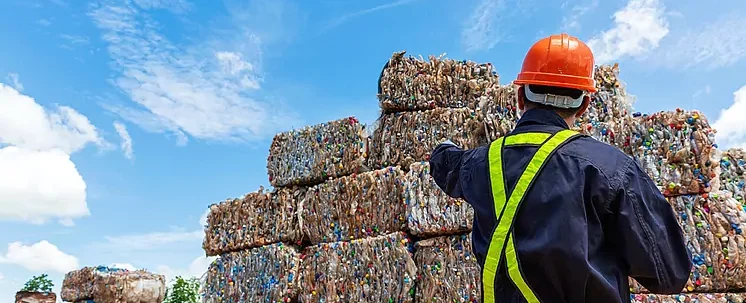“Through the progressive implementation of this model and with an important role of recycling, it is reducing its emissions and generating green jobs. In addition, it aspires, together with other countries, to lead the achievement of the UN Sustainable Development Goals. The reuse of second-hand products also wins integers”.
Produce the same goods and, at the same time, reduce the consumption and waste of raw materials and energy. That is basically the main purpose of the circular economy. On paper, implementing a system based on this principle may seem simple. But to achieve this, it is necessary to break with deep-rooted consumption habits from the last century and which are increasingly harmful. In fact, according to data from the United Nations (UN), the extraction of natural resources has increased by up to 45% since 1970. It is a trend that must be reversed if we want to preserve the planet and achieve the Sustainable Development Goals. (SDG) marked in the UN’s own 2030 Agenda.
Recycling is, without a doubt, the pillar on which a productive and economic system based on circularity must be built. Global figures indicate that administrations are beginning to be aware of the importance of reusing material resources. According to the latest UN report, every year 11,200 tons of solid waste are collected worldwide. The pending subject continues to be plastic, since only 9% of what has been produced throughout history has been recycled. The rest has been incinerated (12%) or accumulated in garbage dumps, landfills or directly in the environment (79%), where its presence is even more dangerous.
It must be taken into account that, in addition, recycling can become a differential vector to reduce greenhouse gas (GHG) emissions. A report on circularity from the World Economic Forum published in 2021 already indicated that 22,800 tons of emissions associated with the manufacture of new products using virgin raw materials could be eliminated by applying reuse strategies.
To this we must add that recycling can become a generator of stable employment throughout the world. Without going any further, UN data indicates that it already employs a total of 12 million people in three global economic powers such as Brazil, China and the United States.
Taking into account these benefits, both economic and environmental, that a system based on the use of resources and the reduction of waste and indiscriminate consumption can generate, the central government has developed the Spanish Circular Economy Strategy (EEEC), aligned with the action plans of the UN and the European Union (EU). This initiative, with a long-term vision, aims to lay the foundations to promote a new production model.
Its main objectives include reducing waste generation by 15% compared to 2010, reducing the national consumption of materials by 30% in relation to GDP (with the year 2010 also as a reference) or increasing reuse until taking advantage of 10 % of municipal waste generated. To achieve these ambitious goals, recycling appears as the axis on which the entire strategy must revolve.
More employment and less CO2
The data indicates that Spain is on the right path to achieve the objectives set for the end of this decade. In 2022, Ecoembes accounted for a total of 1.6 million tons of plastic, metal, brik, and paper and cardboard household containers that were sent to recycling facilities, 3.6% more. For its part, data from Ecovidrio indicate that the selective collection of glass containers amounted to almost 940,000 tons last year, 6.2% more than the previous year.
In environmental terms, from Ecoembes they consider that the recycling of paper, plastic and metal avoided the consumption of 21,460 million liters of water and 6.72 million megawatt-hours (MWh) of energy in 2021, as well as the emission of 1 79 million tons of carbon dioxide. For its part, glass recycling saved the atmosphere from almost 590,000 tons of CO2 and represented an energy saving of 723,351 MWh.
According to Beatriz Egido, director of Communication and CSR at Ecovidrio, this x-ray is a reflection of “the maturity that the recycling habit has reached in our country, and it is also a concrete example that the transition towards a real circular economy not only is necessary, but also possible.
But we must also take into account its great economic potential. Data from the DBK Sectoral Observatory indicate that the production of recycled waste stood at 20.3 million tons in 2022, 2.3%, generating sales of 5,100 million euros. In terms of employment, the Observatory of Sustainability in Spain estimates that the management and treatment of waste gives work to more than 140,000 Spaniards. Of that amount, Ecovidrio estimates that some 8,000 are directly linked to the productive network generated by this organization through glass recycling.
“The entire Ecovidrio value chain is made up of 10 collection companies, 15 glass container treatment plants, 11 glass factories and four container factories,” explains Egido. «Thanks to its capillarity», he adds, «this industrial fabric acts as a socio-territorial backbone and contributes to the development of the local and proximity economy».
In addition to the important role of entities dedicated to recycling, the contribution of citizens and companies is essential to achieve a real change in the production system. In Spain, according to the UN Global Compact, 89% of the Ibex 35 firms and 24% of the companies adhering to this initiative carry out circular economy measures. In addition, 76% have developed plans to improve the efficiency of resources.
An example of this is Repsol, which in recent years has launched several projects to reinforce its commitment to circularity. The most notable is the construction in Puertollano (Ciudad Real) of the first Spanish recycling plant for polyurethane foam, one of the most difficult types of plastic waste to treat at the end of its useful life. Repsol’s intention is to start it up by the end of the year, for which it has undertaken an investment of around 12 million. The plant will have the capacity to process some 2,000 tons of this material per year.
Second hand
Another of the legs of the circular economy is reuse. In this sense, the Spanish second-hand market has not stopped growing over the last five years, experiencing an even greater upturn in these times of inflation. Milanuncios, the oldest national portal in this market segment, confirms this in its latest report. Through a general analysis of the activity of advertisers and buyers, from this website they estimate that in 2022 there was an increase in demand of 4% compared to the previous year. And the trend has continued this year, with year-on-year growth of 5.5% during the first five months of 2023.
As Íñigo Vallejo, PR & Content manager of Milanuncios, comments, this good moment in the second-hand market is the consequence of the “greater presence” of this channel “as a consumer alternative, partly due to the arrival of mobile applications, that have made the task much easier”, but also, “due to a general growth in online shopping”. Likewise, he adds, “it also influences the fact that it has become normal to sell or buy already used products, something that did not happen before.”
The price is one of the main factors that make more and more users opt for this sales channel. But he’s not the only one. “According to our latest survey, 84% of Spanish customers believed that increasing second-hand consumption is more sustainable and almost nine out of ten people confirmed that they wanted to pollute less with their shopping habits,” says Vallejo. In this sense, the data from Milanuncios confirm that the second hand significantly reduced polluting emissions in 2021, specifically, by almost 1.5 million tons of carbon dioxide.
With younger generations increasingly familiar with used products and convinced of their advantages (for example, economic and environmental), it is more than foreseeable that the activity of this leg of the circular economy will continue to grow in the coming years. Its role and that of recycling will be key to the definitive takeoff of a new less polluting and much more sustainable production model.



